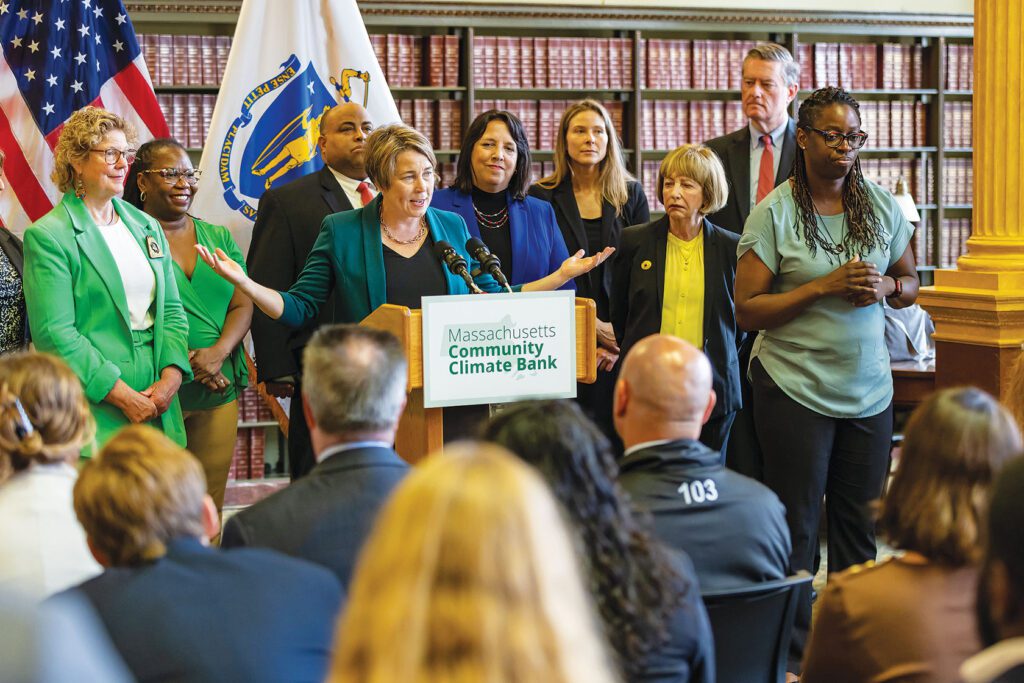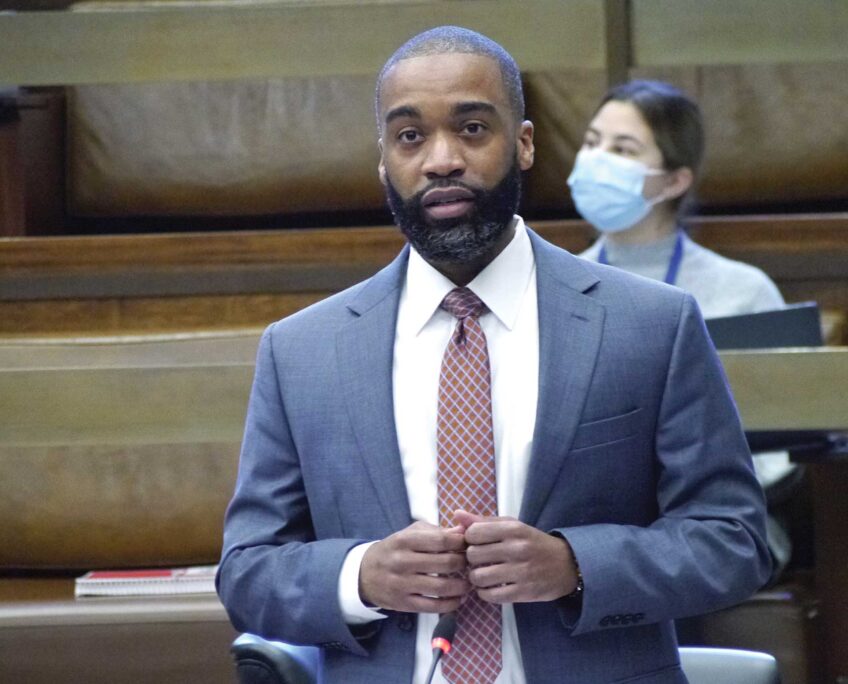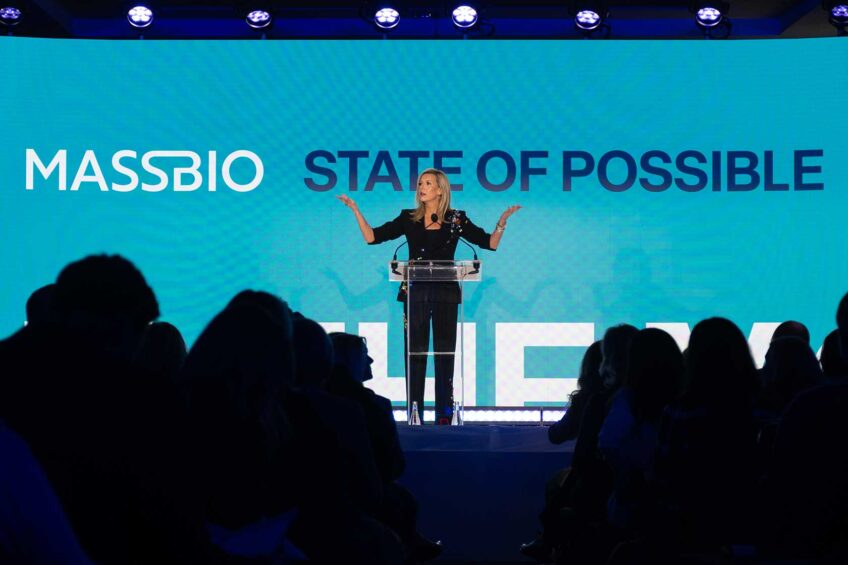New loan program aims to bring clean energy upgrades to low-income households

Clean energy home improvements can be costly, and even with rebate programs, access for low- and moderate-income homeowners can feel out of reach.
The Energy Saver Home Loan Program, a new initiative through the Massachusetts Community Climate Bank, aims to close gaps in access to improvements that can reduce climate impact and save dollars in energy costs.
“Low- and moderate-income homeowners often are the people who have borne higher costs of pollution and energy burden over time,” said Maggie Super Church, director of policies and programs at the Climate Bank. “We want to be sure that they’re really getting the benefit of the transition to a clean energy economy.”
Under the program, homeowners will be able to get loans of up to $100,000 to finance improvements such as weatherization, electrical system upgrades and the installation of systems like heat pumps, electric vehicle chargers and rooftop solar panels. Those changes must reduce total energy usage in the home by 20% to be eligible.
The loans will have below-market interest rates of 0.5% to 2%, based on household income, and will have a 20-year term.
In a neighborhood like Mattapan, the loan program could connect homeowners who are looking to go green with climate-friendly efforts. Fatima Ali-Salaam, chair of the Greater Mattapan Neighborhood Council, said she’s seen growing interest in programs like Mass Save and other clean energy initiatives.
It could also allow needed upgrades of electrical systems that haven’t been replaced since much of the housing stock was built in 1920s or 1950s. Those outdated systems can cause challenges in finding appliances to suit the system, and they can lead to house fires.
“If you can get a low-rate loan, low enough in order to go and upgrade those systems, that’s significant for someone’s health for themselves and for their families,” Ali-Salaam said.
Ali-Salaam said she thinks the loan program from the climate bank will be a good option to add the mix, even if it’s not the right fit for everybody.
“You have a lot of people looking at what it would take to upgrade, or putting in insulation in their homes, or upgrading the old tube-in wiring that used to be in homes,” she said. “People want to do it and are getting educated with how to do it and they want to take advantage of as many different programs that are out there.”
Federal programs and state programs like Mass Save offer rebates on the kinds of clean energy improvements covered by the loan program, but Super Church said that rebates can still pose barriers for homeowners who have to make payments up front and then wait months for the rebates to come in.
“We know that making improvements to your home can be expensive and complicated, and those are homeowners that may have a more difficult time accessing the various federal and state incentive programs and securing a loan to make the improvements,” she said. “We wanted to design a program that made it as easy as possible for those homeowners to access benefits.”
Super Church said she also hopes the program will be able to support homeowners in the long term. In addition to the loan, the program will include concierge services to advise homeowners as they pursue the improvements and create a plan of what changes they might want to make over the 20 years of the loan term.
“Homeowners will have a complete plan for what needs to be done to the home, with an understanding of what to start with and then what might be done later as, say, your hot water heater reaches the end of its useful life, or you’re ready to buy a new car and you want to explore an EV, or your roof needs replacement and then it’s a good time to think about solar,” Super Church said.
That set-up will also help the bank reach more customers. The program is being launched with an initial $20 million, but if homeowners spread out changes over the term of their loan, more people will be able to get started while the program looks to expand and grow.
The Climate Bank is already considering additional funding sources to scale up the program, with additions from the federal Greenhouse Gas Reduction Fund, which is expecting to distribute money out to states and communities later this summer.
The Energy Saver Home Loan Program is the first consumer loan program from the Climate Bank, which was launched last year by MassHousing, a quasi-public agency created by the state in 1966 to create affordable housing, but Super Church said the bank is exploring a number of other loans, some of which would be available directly for homeowners while others would go toward affordable-housing developers and owners.
“Residents and tenants of affordable housing will see some of those benefits, although they won’t necessarily be applying directly,” she said. “Those could be, for example, retrofits of existing properties to make them more energy-efficient or less costly to operate, but those might be projects where the owner or operator of the building is working with the Climate Bank directly to access those loan programs.”
The initiative fits into a broader host of efforts at both state and city levels to make housing greener. In Massachusetts, residential and commercial buildings make up 30% of the state’s energy emissions; 60% of that is generated by single-family and small multi-family homes.
Taking steps to make improvements available to low- and moderate-income homeowners is an important piece of working toward state goals to reduce emissions to net zero by 2050, Super Church said.
“We really can’t reach the state’s climate goals without making a serious effort to decarbonize homes,” she said. “The climate bank was really set up to try and address the dual crisis and challenge of housing affordability and availability as well as emissions reduction.”
Outside of the loan program, at the state level, a grant announced in February 2023 set aside $50 million in total to electrify housing for low- and moderate-income residents.
In March 2023, the city of Boston launched an effort to tackle retrofits in large affordable housing developments. Boston also launched a pilot program in September to provide owner-occupants of two- to four-unit homes $50,000 for electrification and decarbonization.
In a statement to the Banner, Oliver Sellers-Garcia, the city’s Green New Deal chief, said the Massachusetts Community Climate Bank’s new loan program fits in with the existing city programs and will be an important piece of creating opportunities for homeowners to join climate action in the state.
“This work will complement Boston’s Green New Deal efforts … to support a just energy transition for our buildings, ensuring residents aren’t displaced from their homes and communities live healthier through decarbonizing our affordable and public housing units,” he said.






